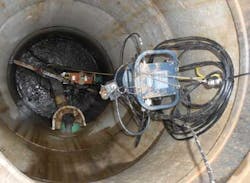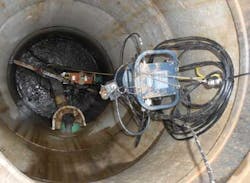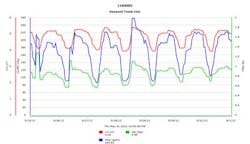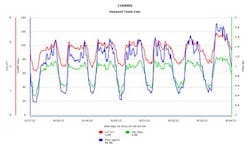Following the Flow: City-Wide Flow Meter Program Improves Aging Wastewater Collection System
The city of Sioux Falls, South Dakota's Public Works Reclamation Department is currently involved in an aggressive, long-term project to identify, quantify and mitigate sources of inflow and infiltration (I/I) in its aging wastewater collection system. The program was initiated in 2010 after substantial rain events inundated portions of its sanitary sewer collection system. Its service area includes 73 square miles and services 159,000 customers. With 800 miles of sewer pipe and over 14,000 manholes in its system, this large project is still considered to be in its infancy, yet the city is already seeing results from its efforts.
With some of Sioux Fall's first piping installed in the early 1890s, it began work on the older basins as a first priority. The use of flow meters that provide accurate flow data is paramount in any I/I program. Further, the city purchased 50 wireless flow meter systems manufactured by Hach Company for the flow monitoring portion of the program. The use of flow monitoring systems that utilize wireless flow loggers and non-contact, web-enabled flow sensors will eliminate the need for routine site visits to collect flow data or perform maintenance reducing the overall program cost for the city.
Each of the 50 flow meter systems comprises a Hach FL900 Wireless Flow Logger and a FLO-DAR radar/velocity sensor. For ease of installation and increased flow meter data accuracy, the Hach FL900 Series Wireless Flow Logger was designed with advanced diagnostics that provide on-site verification of flow meter performance and advanced signal processing with filtering options that reduce noise in difficult applications. Dynamic logging intervals automatically enable the delivery of greater resolution flow data during high flow periods and battery/data volume conservation during low flow seasons. The logger can accommodate up to four plug-and-play sensors with a choice of four sensor technologies. According to Flow Meter Program Coordinator Scott Knutson, who is responsible for meter installations and data reporting, "Setup and calibration are efficient. We typically can set up a meter in under a half hour."
The non-contact FLO-DAR radar velocity/area sensor used with the city's FL900 Flow Logger combines advanced Digital Doppler Radar velocity sensing technology with ultrasonic pulse echo depth sensing to remotely measure open channel flow. By measuring the velocity of the fluid from above, FLO-DAR eliminates accuracy problems inherent with submerged sensors, including sensor disturbances, high solids content and distribution of reflectors. Each of the FLO-DAR sensors is equipped with an optional surcharge velocity sensor that provides uninterrupted and accurate flow monitoring during surcharge or high water conditions.
Sioux Fall's unedited sewer flow meter data is available 24/7 in real-time via FSDATA - a secure website that allows for the management of flow data from Hach wireless flow meter networks. Professional flow data reporting is easily accomplished with FSDATA's graphical web-based user interface. Hydrographs, scatter-plots and tabular data for any logged measurement are provided along with quick summary reports. Knutson added, "I generate numerous sets of data each month for reporting, and FSDATA is flexible and easy to use quickly. The graphing features are particularly useful for generating quick and easy-to-read graphic displays for reports."
A typical flow-monitoring cycle for the meters includes approximately thirty days of monitoring at each location during different times of the year to determine a baseline of wet-versus-dry weather flow. Subsequently, meters are then moved to suspect basins where they are intended to collect rain event data. Collected flow meter data is analyzed by the principal engineers to determine which areas are providing the highest volume of I/I, and maintenance projects are then prioritized, planned and completed. Principal Sanitary Sewer Engineer, Ryan Johnson, PE, added, "We are able to quickly narrow down areas of high needs to really know where to spend our resources."
The city hires summer interns to inspect commercial and residential sump pumps for potential cross-connections. Over the past four years, Sioux Falls has visited approximately 9,000 properties to inspect sump pumps for possible cross-connections to the sanitary sewer. Over 50 sump pump cross-connections have been removed from the system as a result of this program. Generally, the city feels the positive public outreach alone pays for the program. The interns also inspect manholes in high flow areas for potential sources of I/I. Results of this research narrow down the time spent researching repair needs in the field.
Water reclamation teams continue to smoke and die test roof drains and sink holes for possible sources of stormwater cross-connections. These inspections have identified several buildings in older neighborhoods and in the downtown business district with sewer cross-connections. These cross-connections are removed in conjunction with capital improvement projects when applicable. The city's code enforcement team works with residents to mitigate the remaining connections as they are identified.
Results of the initial assessment led to the development of several collection system improvement projects to reduce the risk of future overflows, backups, property damage, and health risks. Ryan commented, "The project is relatively new yet, and we are excited about the results we are getting to date." Approximately $20 million in infrastructure improvement projects were completed within two years of the initial assessment. The projects ranged from capacity improvements to its treatment facility, CIPP lining projects and trunk sanitary sewer replacement and upsizing. One such example involved a lining project for the trunk interceptors to its Hayward trunk line. Prior to the project, the flow averaged 168 gallons per minute (GPM), and after the project was completed, it was reduced to 75 GPM. This significant reduction of I/I in one segment of its system alone was calculated to be a $116,000 annual treatment cost savings.
An additional I/I reduction project is the 2013 Manhole Rehabilitation project with an estimated cost of $99,000. It is anticipated that this project will reduce I/I by 50 GPM during wet weather cycles with an estimated annual cost savings between $10,000 and $25,000. The savings does not include the net savings realized from projects designed to add additional capacity to the POTW.
Ryan added, "The project team will continue using the flow meters to identify and mitigate areas of high I/I. The program provides crucial information to calibrate the system's flow model to assist in justifying, prioritizing and budgeting repair needs. The city will continue to collect and analyze flow data to provide justification for previously-identified, large-expansion projects totaling $42 million."



